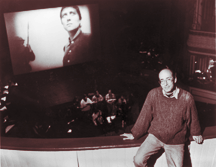Sounding Out the Movies
Cabrillo Music Festival salutes the many sounds of the cinema for summer lineup
By Philip Collins
MUSIC'S VERSATILE yet often-neglected role in film history provides the central focus for Cabrillo Music Festival's 34th season (Aug. 111).
Within the festival's eight-concert series, music director Marin Alsop has programmed five film showings, each with live musical accompaniment. The film lineup is more than a cameo salute, stretching across most of the century and encompassing diverse genres. From the earliest marriages of celluloid and sound to recent experiments, Alsop hopes to demonstrate the myriad ways in which music and film may interact.
Alsop's selection of concert repertoire parallels the cinematic slate in its diversity, with major orchestral scores contrasted by two programs of mischievous enterprise that draw plentifully from popular sources.
James MacMillan's acclaimed percussion concerto, Veni, Veni Emmanuel, Gorecki's Symphony No. 3, Philip Glass' Violin Concerto, Joan Tower's Concerto for Orchestra and other orchestral scores tower like redwoods over the breezy jazz arrangements of Alsop's own 11-piece ensemble, String Fever, and guest composer David Rimelis' playful scores.
Movies, however, get top billing. Early silent comedies, cartoons and full-length features, along with a purely orchestral presentation of Leonard Bernstein's Symphonic Suite from On the Waterfront, offer a wide-angle-lens view of music and cinema's myriad
"I wanted to explore what is one of the 20th century's greatest inspirations for music," says Alsop. "I selected films that have scores which are extremely integral to their success."
Historic re-creations of scores for two of Mack Sennett's silent comedies--Love, Speed & Thrills (1915) and Teddy at the Throttle (1917)--as well as Charlie Chaplin's original music to City Lights are designed to provide illuminating points of reference in the appreciation of Richard Einhorn's 1993 score Voices of Light for Carl Dreyer's 1928 silent classic The Passion of Joan of Arc.
Jean Mitry's adaptation of Arthur Honegger's 1924 symphonic movement Pacific 231 for his 1949 film on trains will demonstrate Einhorn's process in reverse.
In creating a concert version of Chaplin's City Lights, Alsop had to re-create and score countless sound effects. "Chaplin's music is lovely," she explains, "and he envisioned the sound effects as part of the score. It was a replacement for dialogue; in fact it is the dialogue."
The 1920s was a rich decade for experimentalism in cinema. It was a time when filmmakers drew plentifully from the innovations of the contemporary arts--painting, literature and, of course, music. The Passion of Joan of Arc was heralded as a landmark in the genre, but when the original copy and prints were destroyed in two successive fires, the film dropped out of circulation. To the relief of many--except perhaps the Catholic Church--a print was found in 1981.
Einhorn's musical setting of this long-lost masterpiece has been playing to sold-out houses since its premiere in 1993. Scored for four soloists, chorus (Cabrillo Chorus) and orchestra, Einhorn's Voices of Light combines contemporary minimalist vernacular with Dreyer's expressionist imagery to create a hybrid of powerful expression.
"The imagery bores through your brain," says Alsop. "There are lots of close-ups and off-center camera angles, and the characters are contorted."
Einhorn's music counterpoints the film's rapid and irregular camera movements with broad gestures and sustained harmonies. "The music has an otherworldly kind of pace that gives the overall feeling of medieval, chantlike qualities," adds Alsop.
THE MISSION San Juan Bautista concert is the hands-down perennial favorite of the festival, and this year's concise programming of two major, religious-based works--MacMillan's Veni, Veni Emmanuel and Gorecki's Symphony No. 3--perfectly suits the occasion.
One would hardly expect a percussion concerto to be a medium for sacred expression, but Veni, Veni Emmanuel is built exclusively upon the Advent song of the same name. Twenty-year-old Colin Currie (performing here) is one of two percussionists in the world who have mastered the work's extraordinary virtuosities.
Lastly, there is Gorecki's popular Symphony No. 3. The score's tranquil setting of prayers written by concentration-camp prisoners for mezzo-soprano (Wendy Hillhouse) evokes a spirituality of universal appeal that should prove to be among the festival's most exalted finales.
City Lights Gala, Aug. 1; 8pm; $15.
All concerts at the Santa Cruz Civic Auditorium unless indicated. (408/429-3444)
[ Metro | Metroactive Central | Archives ]
This page was designed and created by the Boulevards team.

How Dreyer Am I?: Composer Richard Einhorn screens Carl Dreyer's "The Passion of Joan of Arc," for which he has written a new score.
couplings.
The Cabrillo Music Festival:
Opening Night, featuring works by Honegger, Glass and Tower, Aug. 2; 8pm; $7$24.
Music, Art, Food & Wine Festival, Aug. 34; 11am8pm.
Voices of Light, Aug. 3; 8pm; $7$24.
Free Family Concert, with works by Rimelis, Aug. 4; 2pm.
Music in the Mountains, benefit concert, Aug. 8; 6pm; $75. Lemon Yellow Farm.
String Fever, featuring Mack Sennett comedies, Aug. 9; 8pm; $18.
On the Waterfront, Aug. 10; 8pm; $7$24.
Grand Finale, featuring works by MacMillan and Gorecki, Aug. 11, 4 and 8pm; $25; Mission San Juan Bautista.
From the July 25-31, 1996 issue of Metro
Copyright © 1996 Metro Publishing and Virtual Valley, Inc.
